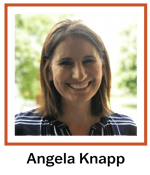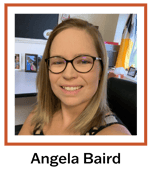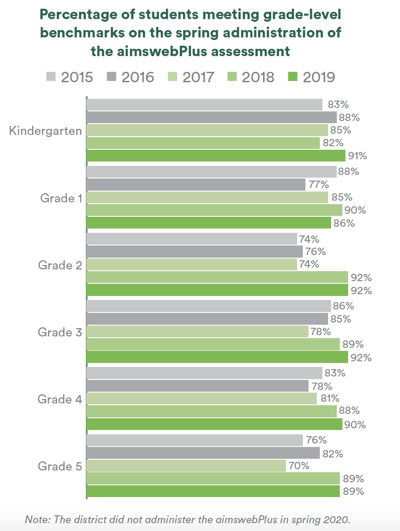Posted in: Aha! Blog > Eureka Math Blog > Professional Development Data Stories Student Achievement > Grassroots Effort Spurs Excellence Outside Wichita
Angela Knapp recalls her anxiety when the Maize Unified School District 266 school board was getting ready to vote in 2017 about whether to adopt Eureka Math® for Grades K–5 for the 2017–2018 school year.

“Our building was terrified,” Knapp says, referring to the possibility that Eureka would not be selected.
If the district didn’t adopt the curriculum, she and her colleagues probably would have quietly kept using it anyway, says Knapp, now a Title 1 math specialist in the fast-growing district outside Wichita.
Knapp, Crystal May, and Angela Baird had a lot at stake. They were the Pray- Woodman Elementary School teachers who first started using the EngageNY Math materials that Karen Duling, now the Maize USD 266 associate superintendent for teaching and learning, had discovered online in 2016. (Great Minds® developed EngageNY Math for New York in 2012–2013 before transforming that curriculum into the first national edition of Eureka Math in 2014.)
DISTRICT PROFILE
10 schools
7,678 students
21% low income
14% with disabilities
Adopted Eureka Math in Kindergarten–Grade 5 in 2017–2018 school year
Now considering expansion to Grades 6–12
The educators knew that the curriculum they had been using could not address the more rigorous requirements of the newly adopted Common Core State Standards, which called for educators to focus on teaching the big concepts of math, not rote memorization of algorithms.
“We knew we had found a goldmine with [Eureka Math/EngageNY Math], but it was super scary. It was so different,” recalls Baird, a Grade 4 teacher. “I was new to the school and was ready for a new adventure. I really dug in with Angela and Crystal. The three of us really bonded. We were in full math nerd mode.”

 May, who had taught Grades 1–4 for 22 years before becoming a student support specialist two years ago, recalls having to totally relearn how to conceptualize and teach fractions. “I remember the students could answer questions faster than I could. They had no baggage to undo. But I learned. Now it is my most favorite thing to teach.”
May, who had taught Grades 1–4 for 22 years before becoming a student support specialist two years ago, recalls having to totally relearn how to conceptualize and teach fractions. “I remember the students could answer questions faster than I could. They had no baggage to undo. But I learned. Now it is my most favorite thing to teach.”
"We knew we had found a goldmine with [Eureka Math/EngageNY Math], but it was super scary. It was so different."
— Angela Baird, Grade 4 teacher
IMPACT ON LEARNING
After several classrooms had success with Eureka Math during the pilot year, the district formally adopted the curriculum for all five of its elementary schools in 2017–2018. Knapp, May, and Baird were delighted.
The teachers say they appreciate Eureka Math’s depth, the flexibility of having different problem-solving strategies, and the coherence across grades. “It’s about understanding, not about memorization anymore. What we were using before had no depth, and the lessons weren’t connected,” says May, who is also a Eureka Math seasonal associate, providing professional development to other educators during the summer.

Since adopting Eureka Math, the district has seen steady gains in student achievement on the annual aimswebPlus assessment.
CONVERTING SKEPTICS
Duling helped shepherd the adoption process, especially getting teachers on board. “We worked hard to come to a consensus with teachers,” she says. “Grassroots is a huge part of our success. By the time the board voted, teachers had already embraced the curriculum.”
To be sure, there were still some skeptics. Duling recalls one veteran teacher complaining that the materials were not teacher friendly and that mastering the new curriculum was the hardest work of her teaching career. But by the second semester of the 2017–2018 school year, “she was seeing her students doing things she’d never seen them do before” and became a convert.
One of the last holdouts returned from a Great Minds training workshop in Atlanta “on fire and the biggest believer,” Duling says. “She wanted to talk to all our teachers about her experience.”
“on fire and the biggest believer,” Duling says. “She wanted to talk to all our teachers about her experience.”
The convert’s aha moment came when she recalled how hard it was to read the Harry Potter books to her five year old; they both had to learn the new vocabulary in the novels.
Some of the Eureka Math vocabulary was as foreign to her as the Harry Potter vocabulary had been. But when the teacher recalled the productive—and ultimately fruitful—struggle she and her child had had learning about Harry Potter, a lightbulb went off. And she joined her colleagues in learning the new math curriculum.
"Grassroots is a huge part of our success. By the time the board voted, teachers had already embraced the curriculum."
— Karen Duling, Associate Superintendent for Teaching and Learning
STRONG DISTRICT SUPPORT
The district has helped teachers master Eureka Math’s rigorous and unique instructional approaches in several ways. Educators attend Great Minds trainings. Instructional coaches such as May model lessons for teachers. And professional learning communities address common questions and help teachers see the cross-grade connections.
“When I first started in Grade 4, I had to go back to Kindergarten [to learn key concepts],” Grade 4 teacher Baird recalls. “We spend a lot of time on the [Common Core] Progressions,” she adds, saying that teachers are eager learners. “They’re ready and hungry for practical tips and to understand why the curriculum was written this way.”
Maize educators have the following advice for schools just starting to use Eureka Math. Implement with fidelity: “That’s our ‘F’ word,” Duling says. Be brave. Take time to study the materials. Give teachers the space to feel uncomfortable and grow. Create multiple opportunities for teachers to learn from each other.
“Have as many cross-grade discussions as possible to show the coherence,” Knapp says.
"There will be some rough waters, but they will calm. In the end, you will be so amazed."
— Crystal May, Student Support Specialist
Most important, celebrate student success, and stay the course. It takes a year or two to see the curriculum’s full impact on learning, according to May.
“There will be some rough waters, but they will calm,” she says. “In the end, you will be so amazed.”
Submit the Form to Print

Jenny Taylor
Jenny has over a decade of experience in education policy and research. She has worked with states and districts on the development and implementation of college and career readiness policies, especially around the implementation of rigorous standards and high-quality instructional materials. She has extensive knowledge about K–12 standards, graduation requirements, assessments, and accountability systems nationwide. Additionally, she has conducted research for school districts to address pressing needs in those districts. Jenny received her B.A. in English and education from Bucknell University and her M.Ed. in education policy from the University of Pennsylvania Graduate School of Education.
Topics: Professional Development Data Stories Student Achievement





.jpg?width=430&name=PhD%20Science%20(1).jpg)





.jpg?width=430&name=EurekaMath%20(1).jpg)
.jpg?width=430&name=WitWisdom%20(1).jpg)

